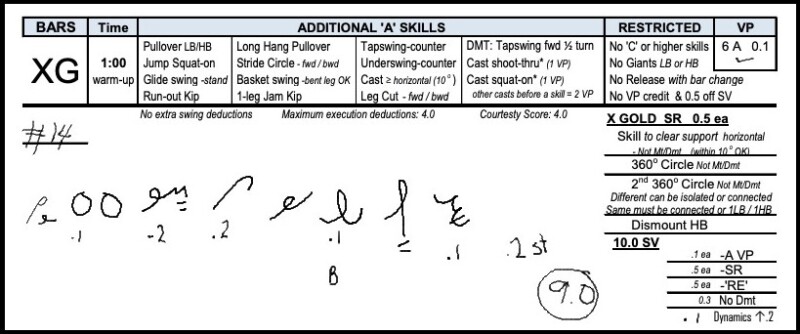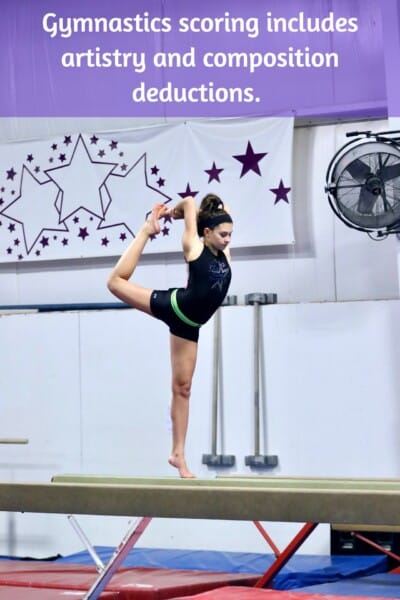Understanding Gymnastics Scoring: From Artistry to Execution
Updated February 2024
Gymnastics competitions are fun to watch, but it can also be frustrating when you don’t understand how the gymnastics scoring system works!
Judging is a very complex process. Becoming certified as a judge for women’s gymnastics requires an intense amount of studying, memorization, testing, experience, and continued education.
Judge Ranking
Judges are ranked at Xcel, Level 4/5, Level 6/7/8, Level 9, Level 10, National, and Brevet. A judge’s rank determines which level gymnasts they are permitted to judge. Their hourly pay is determined by USA Gymnastics according to what rank they are.
By the time a judge is studying for the Level 9 rank, it is not uncommon for them to fail the testing several times due to the difficulty involved.The majority of judges that you see at the optional competitions are ranked as Level 10 or higher.

Accuracy in Judging
That being said, try to be patient and trusting at the times when you do not understand the scores that are given out. Respectfully realize that in most cases the judge is applying deductions accurately. It takes many, many years of personal experience in this sport to have the understanding and the trained eye that is required to comprehend how every part of the scoring works.
We have listed some simplified explanations and examples listed here that we hope will give you a basic understanding of how the gymnastics scoring system works.
Please note: The explanations below are in regards to the gymnastics scoring system which is used for “Optional” levels within the USAG Women’s Developmental and Xcel Programs. This includes all Xcel divisions (Bronze, Silver, Gold, Platinum, Diamond, and Sapphire) as well as Levels 6-10. The compulsory levels 1-5 have somewhat different rules in their scoring which are not outlined in this article.
Gymnastics Scoring: Is Anything Missing?
Start Value
Gymnastics scoring begins with the “Start Value” of a routine. When a gymnast’s Start Value is a 10.0, this means that all the Special Requirements and Value Parts that are required for their level were present in the routine.
The competitive level of the gymnast determines the starting score:
- Level 10 starts at 9.50
- Xcel Sapphire starts at 9.60
- Level 9 starts at 9.70
- Level 6 / 7 / 8 and all other Xcel levels start at 10.0
All deductions that a gymnast receives on their performance are subtracted from their Start Value, which results in their final score. Usually the Start Value is displayed at the judges table right at the end of each routine where coaches can see it clearly. Occasionally Start Value is displayed on digital scoring displays as well.

Special Requirements
On balance beam, uneven bars, and floor exercise there are four Special Requirements that must be included in the gymnast’s routine. (Vault has a separate set of scoring requirements.) Each of these requirements is worth 0.5. If a gymnast is missing one of their Special Requirements, 0.5 is deducted from their Start Value.
Some of the current Special Requirements (through 2026) for Xcel divisions include:
Bronze Floor
- 1st acro pass: minimum 2 acro elements, flight or non-flight
- 2nd acro pass: 1 acro element, flight or non-flight
- Dance passage (2 Group 1 elements) including 60° leap off 1 foot
-
Minimum 1/2 turn on one foot
Silver Bars
- Mount
- Cast to minimum 45° below horizontal
- 360° circling skill
- Dismount from low bar or high bar (no saltos)
Gold Beam
- Minimum 1/1 turn on one foot
- 2 different leaps/jumps, 1 with minimum 120° split (isolated or in a series)
- 2 acro skills, with or without flight, 1 must achieve or pass through vertical
- Dismount
Platinum Floor
- 1st acro pass: Minimum 2 flight elements including “A” or “B” salto
- 2nd acro pass: 2 flight elements OR B salto
- Dance passage (2 Group 1 elements) including 150° leap off 1 foot
- Minimum 1/1 turn on 1 foot
Diamond Bars
- Skill finishing in a clear support at minimum 45° from vertical
- Min. “B” 360° circling skill
- Min. “B” skill with release, pirouette, or a 2nd 360° circling skill
- Salto or hecht dismount from high bar: Minimum “A”
Sapphire Beam
- Minimum of 1/1 (360°) turn on one foot
- Dance series with 2 skills (including a leap or jump with 180º angle (in a series or isolated)
- One acro series with a minimum of 1 flight skill
- “B” dismount OR an acro flight skill connected to a salto/aerial dismount

Value Parts
In gymnastics scoring, every skill has an assigned value. Beginner level skills are designated as “A” Value Parts. More advanced skills are designated as “B”. Values continue to rise through “E” as the difficulty of the skill increases.
Each Value Part has a point value attached to it. “A” Value Parts are worth 0.1; “B” Value Parts are worth 0.3, and “C” Value Parts are worth 0.5. If a gymnast is missing one of the Value Parts required for her level, it comes off her Start Value.
Xcel Value parts:
- Bronze = 4 A’s
- Silver = 5 A’s
- Gold = 6 A’s
- Platinum = 6 A’s, 1 B
- Diamond = 5 A’s, 2 B’s
- Sapphire = 3 A’s, 3 B’s, 1 C (C is eligible for bonus)
Optional Levels
- Level 6 = 5 A’s, 1 B
- Level 7 = 5 A’s, 2 B’s
- Level 8 = 4 A’s, 4 B’s
- Level 9 = 3 A’s, 4 B’s
- Level 10 = 3 A’s, 3 B’s, 2 C’s
If a Gold gymnast only has five A’s present in her routine, she is missing one “A”. Her Start Value goes down to a 9.9. If a Level 9 gymnast is missing one “B”, her Start Value drops to 9.4.
Execution Deductions
Execution deductions are the points a judge deducts based on how correctly each skill is performed. These fall into four categories of faults: small, medium, large, and very large.
Small Faults: 0.05 – 0.15
- up to 0.1: Arm swings on landing to maintain balance
- 0.1: for each small step on landing (max 0.4)
- 0.1: Lands with feet further than hip-width apart
- 0.05: Poor foot form during Value Parts
Medium Faults: up to 0.2
- Leg or knee separations
- Incomplete turn or twist
- Large step or jump on landing (max 0.4)
Large Faults: up to 0.3
- Bent arms or legs
- Wobbles to maintain balance
- Squat on landing
- Incorrect body shape in any given skill
Very Large Faults: 0.5
- Fall onto or off apparatus
- Spotting assistance (plus no Value Part credited for the element that was spotted)
Balance beam, floor exercise, and uneven bars each have specific deductions applied in addition to the examples of general deductions listed above.
Artistry Deductions
Artistry deductions are also applied in gymnastics scoring for beam and floor. Judges are looking for things like amplitude, expression, maturity, confidence, and personal style during their routines. Specific deductions are used when a gymnast fails to demonstrate these qualities. A deduction of up to 0.3 may be applied.
Composition Deductions
Gymnastics scoring also includes composition deductions for bars, beam and floor in levels 8, 9, and 10. Judges evaluate the difficulty of the skills performed, rather than the artistry. These are not easily spotted by the untrained eye and can leave viewers a bit shocked when the final score is posted. An otherwise perfectly executed routine could lose a point over these ‘hidden’ deductions.
Judges want to see routines that are ‘Up to the Level’ in three categories: Acro (tumbling passes), Dance, and Dismounts. These must meet certain expectations for each level. A Level 9 gymnast, for example, should be performing a minimum of “B” and “C” acro and dance skills in their passes, including the final acro pass. Deductions of up to 0.2 can be applied to each category. A few other things judges also look for in routines are both front and back tumbling, using the whole floor space, and if the difficulty of elements is spread evenly throughout the routine.

Neutral Deductions
Neutral deductions are flat deductions that are applied to the score by the head judge before the score is official. For example, there is a neutral deduction of 0.1 for any gymnast whose beam or floor routine goes over the time limit that applies to her level. If the score for a gymnast who just competed on beam is a 9.0, but she went overtime, the head judge applies the 0.1 neutral deduction to the score, which officially makes it an 8.9. Stepping out of bounds on the floor also receives a deduction of 0.1.
Other General Deductions
The USAG gymanstics scoring system also allows for other general deductions which help the judge separate one gymnast from the next, especially when scores are tight. These include:
- Dynamics: up to 0.2
- Rhythm: up to 0.2
- Sureness: up to 0.2
- Footwork: up to 0.3
- Posture: up to.3
Bonus
In addition to the above, gymnastics scoring involves earning bonus points for upper levels. At all levels, except for Xcel Sapphire and levels 9 and 10, bonus points are not needed or given. Athletes start at a 10.0 as long as they have fulfilled all their Special Requirements and performed the amount of Value Parts required for their level.
Xcel Sapphire, Level 9 and 10 athletes need to earn bonus points in order for their routines to be at a 10.0 Start Value.
If all Special Requirements and Value Parts are fulfilled, the Start Value is 9.7 for Level 9, 9.6 for Sapphire, and 9.5 for Level 10. Each gymnast must earn the reminder in bonus in order to make her Start Value a 10.0.
The Level 9 athlete may earn her 0.3 bonus by performing certain connections of higher Value Part skills and earn a difficulty bonus of .1 for each allowable D or E acro skill performed.
Sapphire athletes may also earn their 0.4 bonus through connections or higher Value Parts and earn a difficulty bonus of .1 for each C skill. She may perform D skills in a routine, but she may receive a 0.1 bonus for only ONE of them. No E’s are allowed.
The Level 10 athlete may not only earn her 0.5 bonus through connections of higher Value Parts, but also through difficulty bonus by including a D or E Value Part in her routine. D Value Parts earn her 0.1 bonus and E Value Parts earn her 0.2 bonus. A Level 10 is not permitted to earn all 0.5 of her bonus solely by connection bonus or difficulty bonus. She must have a combination of both types of bonus in order to reach her 10.0 Start Value.
Final Score
A gymnast’s final score is calculated by determining her Start Value and then subtracting all other applicable deductions from that. (Execution, artistry, neutral, etc.)
When there is a double judge panel, each judge determines their final score independently. The two scores are then averaged to result in the official score.
Skill Selection
Skill selection is the task of coaches and athletes choosing which skills to include in their routines. This can be a tricky balancing act. Coaches do their best to choose skills that are mastered well enough so the gymnast receives minimal deductions. At the same time, the athlete may have their own ideas of what skills they want to put in their routine. Coaches need a good basic understanding of gymnastics scoring in order to achieve this healthy balance. The ability of a gymnast to be involved in choosing the skills she competes grows as she becomes more experienced and mature in her gymnastics training.
Individual Scoring and Placing
Gymnasts are placed individually among all the other girls who competed in her level and age group. This is done for each event as well as for All Around. The All Around score is the total of all event scores added together.
Team Scoring and Placing
To qualify as a team, there must be at least three members competing. The team score is typically determined by taking the top three scores on each event in a level and adding them together. This gives smaller gymnastics clubs with only a few members in each level or division a better chance at receiving a team award when competing against large clubs and teams.

Vault Scoring*
The gymnastics scoring system for vault is entirely different than the other three events.There are no Special Requirements or Value Parts on vault, unlike all the other events. Instead, each vault has its own assigned Start Value.
In most cases, the gymnast is permitted to vault two times. The judges determine the official score for each vault. The higher scoring vault is used as the gymnast’s official score.
At the beginner divisions (Bronze, Silver, and Gold) each division has some limited options of what vault they may perform. There is a vault for each division that has a 10.0 Start Value. There is also a simplified version of the vault that coaches can choose to compete which have Start Values of either 9.0 or 9.5.
Levels 6 and 7 have three vaults to choose from, each valued at 10.0.
Beginning with the Xcel Platinum division and Level 8, Start Values range according to the difficulty of the vault and the expectation of the division or level. For example, if a Platinum gymnast performs a front handspring, her Start Value is 9.7. The same vault performed by a Level 8 drops to a 9.0. And a Level 9 would need to perform a front handspring with a full twist in order to receive 9.0 Start Value.
Execution deductions are taken in all phases of the vault. These are subtracted from the vault’s Start Value to calculate the final score.
*Find a more thorough explanation about vault judging here: Gymnastics Vault Scoring: What Judges See That You Don’t
As you can see, the gymnastics scoring system for USAG is quite detailed! Women’s gymnastics is very competitive. In order to make distinctions between the best gymnasts during sanctioned events, judges must have enough criteria to choose from. If two gymnasts perform outstanding routines with almost no execution deductions and fulfill all requirements, a judge may notice one sickle foot error and subtract 0.05 from her final score. This is enough to separate the best from the best of the best!
For those gymnastic nerds out there who love numbers and calculations, you can find all the nitty gritty details in the Code of Points for both the Optional Levels and Xcel Divisions on the USAG website.
EmethGym has been producing quality, high level competitors for over two decades. Our programs do not only focus on careful progression of skills, but also on building the character needed to compete in such a demanding sport. We use our sports programs – gymnastics, ninja and tumbling – to develop the character students need to become confident leaders of their generation. It is character that lasts a lifetime and allows people to achieve the goals they set. All students in both our team and progressional programs receive character training during each class. One quality per season is chosen as a focus and includes practical application during their gym time. We are committed to build both strong bodies and minds.


